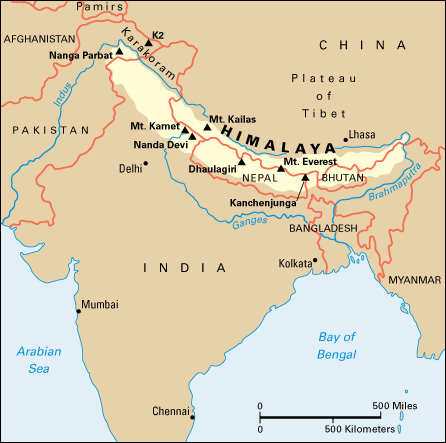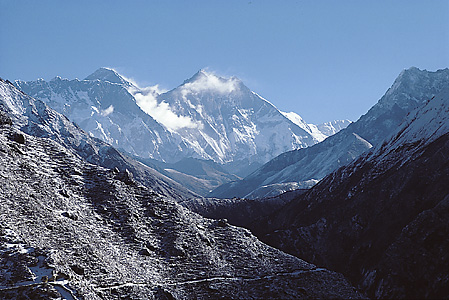Himalaya, << `hih` muh LAY uh or hih MAHL yuh, >> also called Himalayas, is the highest mountain system in the world. The name Himalaya means Abode of Snow, or the Snowy Range, in Sanskrit. The Himalaya consists of several parallel mountain ranges.

The mountains extend in a 1,500-mile (2,410-kilometer) curve across southern Asia, from the great bend of the Indus River in Pakistan eastward to the great bend of the Brahmaputra River. They form a geographical barrier that separates northern India from the plateau of Tibet, in China. Parts of the Himalaya system are as much as 200 miles (320 kilometers) wide. The Himalaya joins with other large mountain ranges in Asia, including the Hindu Kush, Pamir, and Karakoram ranges in the northwest and the Hengduan Range to the east.
Peaks.
The Himalaya rises in steps from the plains of northern India, which have an elevation of about 1,000 feet (300 meters) above sea level. Mount Everest (29,032 feet, or 8,849 meters), which lies between Tibet and Nepal, is the highest mountain in the world. K2 (28,250 feet, or 8,611 meters), in the Karakoram Range, is the world’s second highest mountain.

One of the most famous peaks in the Himalaya is Mount Kailas (22,028 feet, or 6,714 meters), which lies in Tibet. The Tibetans call it Kang Rimpoche (the Precious Jewel of Snows). This mountain is holy to Hindus and Buddhists, who believe it contains the thrones of their gods and saints. Pilgrims from central and southern Asia visit the mountain. They circle it on foot, and the journey may take them from tropical jungles to freezing heights. Lying below the peak is the holy Lake Manasarowar, where the pilgrims congregate and worship.

Kanchenjunga, or Kinchinjunga (28,169 feet, or 8,586 meters), the third highest mountain in the world, lies near Mount Everest. Other high peaks are Makalu (27,824 feet, or 8,481 meters); Dhaulagiri (26,810 feet, or 8,172 meters); Nanga Parbat (26,660 feet, or 8,126 meters); Annapurna (26,504 feet, or 8,078 meters); and Mount Kamet (25,447 feet, or 7,756 meters).
Passes and glaciers.

The passes that run through the Himalaya are among the highest in the world. Few of the passes are lower than 15,000 or 16,000 feet (4,570 or 4,880 meters) above sea level. Most are covered with snow from November to May and are then impossible to cross. Many glaciers are found in the high altitudes, and some are slowly melting.
Climate and plant life.
Almost every kind of climate can be found in the Himalaya because of the great difference in altitude in various parts of the range. This wide range in climate makes possible a variety of plant life. On the steep southern slopes grow tropical plants, such as the fig and palm tree. These plants are found up to a height of 3,000 feet (910 meters). Oak, chestnut, and laurel trees are common up to 7,000 feet (2,100 meters). Cedar and other conifer trees begin to appear at 12,000 feet (3,660 meters). Many shrubs and climbing plants are found in the forests. Rhododendrons grow on the mountain slopes. The tea plant is cultivated up to 5,000 feet (1,500 meters). Farmers on the southern slopes grow rice, corn, and millet up to 6,000 feet (1,800 meters). Wheat and barley are grown in higher regions.
Animal life.
The Himalaya has many animals that live in tropical, temperate, and cold regions. Tigers, leopards, rhinoceroses, elephants, yaks, and some kinds of monkeys are found there.
